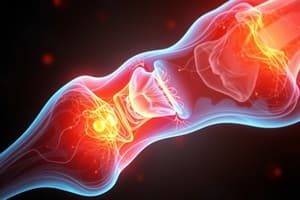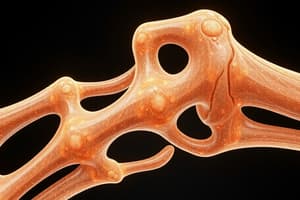Podcast
Questions and Answers
What is the histological classification of normal adult bone?
What is the histological classification of normal adult bone?
- Non-lamellar bone
- Lamellar bone (correct)
- Immature bone
- Woven bone
In which condition is immature bone present in adults?
In which condition is immature bone present in adults?
- Fracture healing
- Osteo-tendineal junctions
- Alveolar sockets
- All of the above (correct)
What is the original cell type from which osteocytes, osteoblasts, and osteoclasts develop?
What is the original cell type from which osteocytes, osteoblasts, and osteoclasts develop?
- Mesenchymal osteoprogenitor cell (correct)
- Hematopoietic stem cell
- Fibroblast
- Chondrocyte
What is the major tissue component in bones, cartilage, and tendons?
What is the major tissue component in bones, cartilage, and tendons?
In which condition is non-lamellar or woven bone present in adults?
In which condition is non-lamellar or woven bone present in adults?
What is the characteristic of immature bone in terms of collagen fiber organization?
What is the characteristic of immature bone in terms of collagen fiber organization?
What are the three mechanisms of bone formation?
What are the three mechanisms of bone formation?
What is the main mechanism for fracture repair and bone growth in length?
What is the main mechanism for fracture repair and bone growth in length?
What stimulates the release of growth factors that promote vasodilation and angiogenesis?
What stimulates the release of growth factors that promote vasodilation and angiogenesis?
What is responsible for appositional growth of bone?
What is responsible for appositional growth of bone?
What is a solution of continuity of a bone segment due to mechanical trauma?
What is a solution of continuity of a bone segment due to mechanical trauma?
What plays a crucial role in bone healing?
What plays a crucial role in bone healing?
What is the primary inorganic component of the bone matrix?
What is the primary inorganic component of the bone matrix?
Where are osteoblasts primarily found?
Where are osteoblasts primarily found?
What is the primary function of osteocytes?
What is the primary function of osteocytes?
What is the origin of osteoclasts?
What is the origin of osteoclasts?
Which cell type is responsible for bone reabsorption?
Which cell type is responsible for bone reabsorption?
What does Wolff's law state about bone structure?
What does Wolff's law state about bone structure?
Which type of bone healing occurs with absolute stability constructs?
Which type of bone healing occurs with absolute stability constructs?
What type of bone healing involves periosteum and external soft tissues?
What type of bone healing involves periosteum and external soft tissues?
Which hormones play a role in bone healing?
Which hormones play a role in bone healing?
What is the time range for calcification of bone callus for healing?
What is the time range for calcification of bone callus for healing?
Which type of cartilage lacks blood supply, lymphatic drainage, and neural elements?
Which type of cartilage lacks blood supply, lymphatic drainage, and neural elements?
What does the remodelling phase of bone healing involve?
What does the remodelling phase of bone healing involve?
Which mechanism of bone healing involves minimal movements between bone ends?
Which mechanism of bone healing involves minimal movements between bone ends?
What is the phase of bone callus formation that involves the development of fibrous callus and cartilage metaplasia?
What is the phase of bone callus formation that involves the development of fibrous callus and cartilage metaplasia?
What is crucial for re-vascularization and bone healing?
What is crucial for re-vascularization and bone healing?
Which phase of bone callus formation involves the development of periosteal and intramedullary callus?
Which phase of bone callus formation involves the development of periosteal and intramedullary callus?
What is the primary requirement for the direct mechanism of bone healing?
What is the primary requirement for the direct mechanism of bone healing?
What stimulates bone growth?
What stimulates bone growth?
Flashcards are hidden until you start studying
Study Notes
Bone Healing Mechanism and Phases: A Comprehensive Overview
- Bone healing process involves the release of growth factors, leading to increased blood flow at fracture sites, peaking at two weeks post-fracture.
- Mechanical stability is crucial for re-vascularization and bone healing, as proper healing depends on a balance between micromovements, mechanical load, and bone response.
- Bone growth is stimulated by loading, and proper positioning of fractured bones is critical for healing.
- Inadequate stabilization can lead to mechanical deformations preventing bone formation, while excessive stabilization reduces callus formation.
- There are two mechanisms of bone healing: direct (no callus, no cartilage formation) and indirect (intermediate callus formation).
- Direct mechanism requires absolute stability, leading to osteoblast-mediated direct formation of osteons.
- Indirect mechanism involves minimal movements between bone ends, leading to periosteal reaction, medullary callus formation, and endochondral ossification.
- The phases of bone callus formation include inflammation and hematoma formation, soft callus formation, calcification and hardening of the callus, and remodeling of the callus.
- The hematoma, formed within the first 20 days, contains growth factors that stimulate vessel growth and cell migration towards the fracture site.
- The conjunction callus phase, occurring from day 20 to 30, involves the development of fibrous callus, cartilage metaplasia, and ossification.
- The calcification and repairing phase includes the development of periosteal and intramedullary callus, stimulated by mechanical and chemical factors.
- The healing process involves the transformation of cartilage to woven bone by osteoblasts, leading to the formation of callus, which can be observed in radiological images of fractures.
Studying That Suits You
Use AI to generate personalized quizzes and flashcards to suit your learning preferences.




